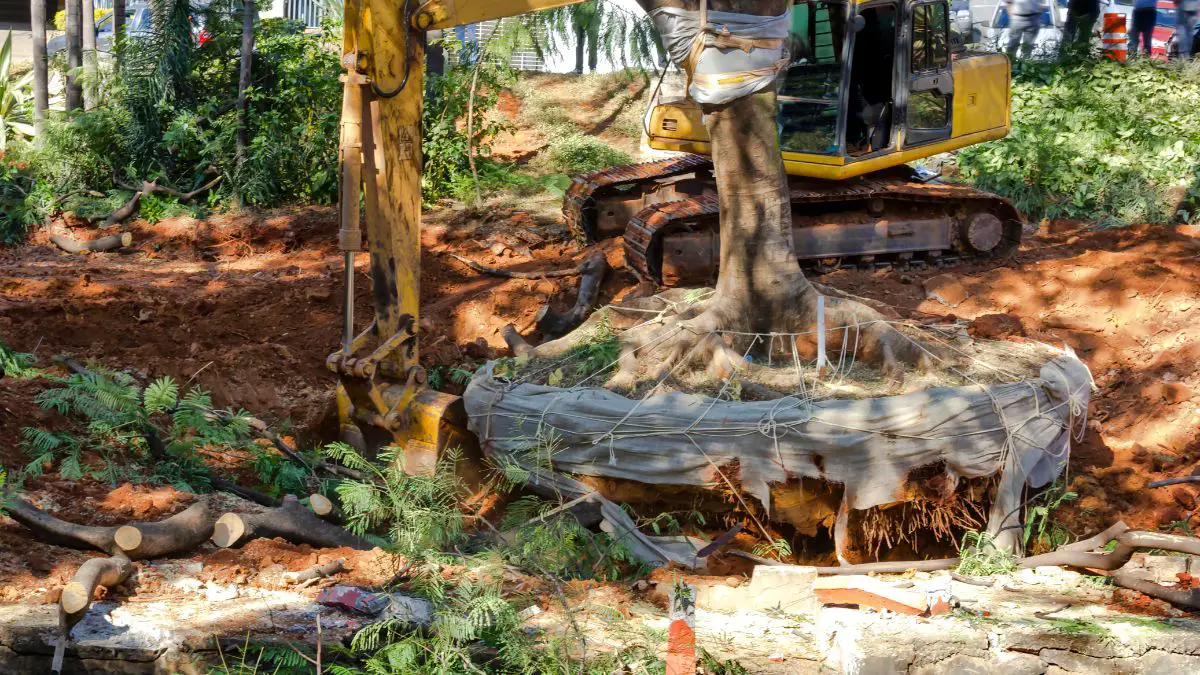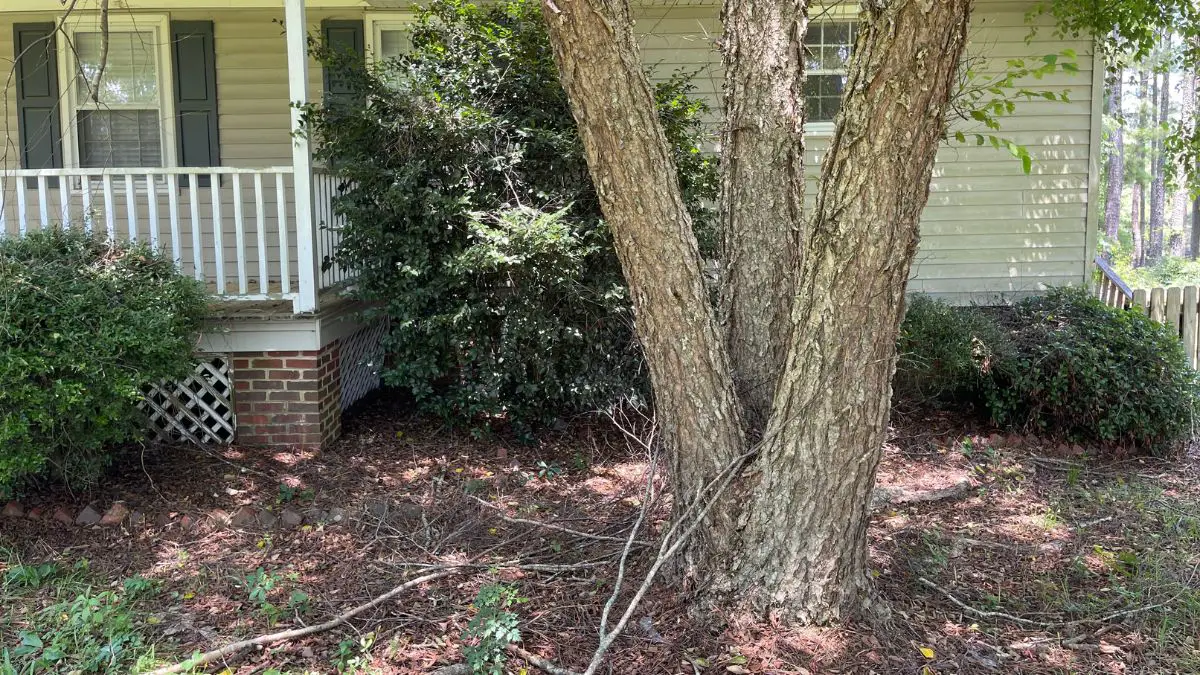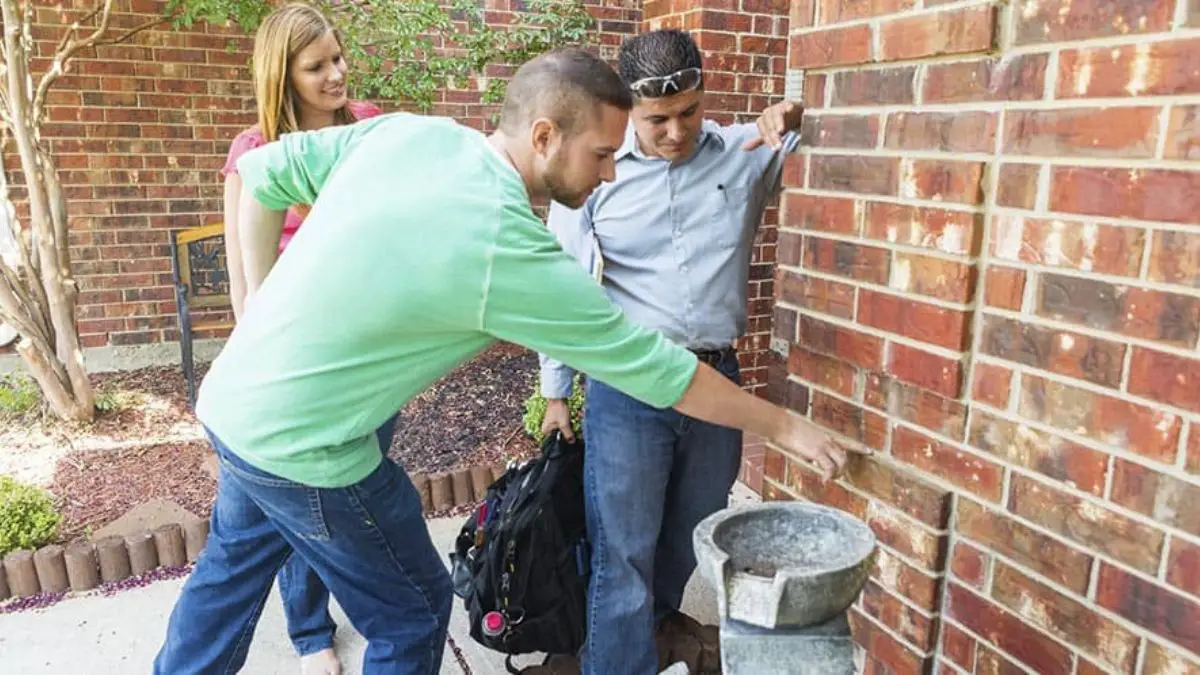Undeniably, trees are a valuable asset to our environment and a sign of a thriving landscape. They provide shade and privacy, improve air quality, offer habitats for wildlife, and play a vital role in reducing soil erosion and salinity.
It is important to note that consequences arise from planting trees near walkways, driveways, buildings, and home foundations. The most important question is, “Can removing a tree cause foundation problems?“.
Yes, but it depends on the proximity and how large the tree’s root system is. Trees play a vital role in soil stability and moisture regulation. Removing a tree can cause the soil to shift and settle, leading to hairline cracks, uneven flooring, and doors that are not functioning properly.
By understanding foundation tree root damage signs caused by tree removal, homeowners can take preventive measures such as planting new tree species away from their homes or installing a root barrier before removing a tree.

Can Removing a Tree Cause Foundation Problems?
Whether removing a tree can cause foundation problems concerns many homeowners. The answer is yes; it can.
Depending on how close the tree is to your home and how large its extensive root system is, removing it without proper precautions and the assistance of a tree removal expert or tree service can potentially result in serious structural damage.
It is best to get advice on tree removal from tree removal services or a tree service that can assess the situation and safely remove the tree while minimizing any potential impact on the foundation.
The Role of Trees in Soil Stabilization
We will delve into the complex interconnection between trees and soil and explore these majestic plants’ significant role in maintaining the soil that supports our ecosystems.
Stabilizing Soil Around Foundations
Trees help stabilize the soil surface around foundations by holding the soil together with their roots. Roots of trees grow in various directions, including vertically and horizontally, penetrating deep into any soil. As roots grow and spread, they create a fibers network that physically intertwines with soil particles.
The intricate system of roots serves as a strengthening foundation, promoting soil cohesion and enhancing its overall stability. This prevents soil displacement and settling, offering a firm base for foundations. It is likely why residential areas avoid cutting down trees nearby.
Fact
A study conducted by Texas A&M University showed that a home with nearby trees can increase their property value by up to 7% higher than those without a quality landscape. This means that trees stimulate economic growth by attracting new businesses and tourism to an area.
Retail areas with beautiful trees tend to be more attractive to shoppers while apartments with a wooded setting rent quickly and tenants tend to stay longer.
Roots Absorb Water from the Soil, Preventing Soil Expansion
Tree roots absorb water to keep a tree alive, and while these trees absorb water from surrounding soils, they reduce what is known as “swelling potential” within clay-rich soils. Swelling potential is essentially how much clay soils will expand when they are exposed to different levels of moisture over time.
Trees have been shown to reduce swelling potential within clay-rich soils thanks to their ability to absorb large amounts of water before it reaches critical depths below building foundations. Active tree roots act like sponges; they absorb and release water during heavy rainfall during dry periods.

The Ripple Effect of Tree Removal on Foundations
Soil expands when it gets wet and contracts when it dries out. The extent of this expansion and contraction depends on various factors such as clay content, permeability, and water content.
When a tree is removed from a location near a foundation, there is an immediate effect on moisture levels within that area because evapotranspiration stops abruptly.
Common signs of foundation damage from invasive roots include:
- Crack walls. Vertical cracks usually appear due to normal settling over time, but horizontal or diagonal ones are serious since they suggest structural damage rather than just cosmetic damage.
- Uneven foundation floors indicate an unstable foundation that needs immediate attention. If there are problems with this important base layer, such as soil height variations, then everything else will fail.
- Doors that won’t close properly are a sign of movement in your home’s structure, which may be caused by shifts in soil quality due to tree removal.
If you notice any of these warning signs, it’s essential to contact a professional contractor with experience dealing with foundation repair as soon as possible.
Professional foundation experts can also help identify if there are any potential risks to water pipes, underground pipes, sewage pipes (or sewer pipes), or other water damages due to aggressive root systems.
Related reading: Are Trees Bad For Foundations: Which Trees Affect Houses, Fixes & Prevention
Is It Better to Remove Trees to Save a Foundation or Not?
The decision to remove trees to save thousands of foundations will depend on several factors and should be evaluated case-by-case.
5 Important Considerations
- The severity of the foundation issue: If the foundation is severely damaged and in immediate danger of collapse or extensive structural damage, removing trees is necessary to prevent further deterioration or potential safety hazards.
- Tree health and stability: If the trees are unhealthy, diseased, or structurally compromised, their removal might be warranted regardless of the foundation concerns. Unstable trees pose a risk of falling and causing damage to the property.
- Tree species and root system: Determine whether the roots of the trees are non-aggressive root systems (shallow root systems, fibrous root systems) that don’t directly affect the foundation. Consulting with an arborist or a qualified professional can help assess the specific situation.
- Alternative solutions: Implement root barriers or foundation underpinning techniques to help mitigate the impact of tree roots on the foundation.
- Environmental and aesthetic considerations: Consider the benefits of trees including providing shade, improving air quality, promoting biodiversity, and habitat for wildlife. They contribute to the aesthetics and overall value of a property.
4 Tips for Preventing Tree-related Foundation Issues
When considering tree removal, it is important to take steps to prevent foundation issues.
Tip #1: Plant new trees away from the foundation.
When removing a dangerous tree and replacing it with a new tree species of tree, ensure that they are planted at a safe distance from the foundation or other structures. This helps to create a buffer zone, reducing the risk of soil movement caused by changing amounts of moisture.
Tip #2: Consider mature tree size, tree species, and proximity to structures.
Before planting new trees, carefully assess their projected mature size and ensure they will not grow too close to any buildings or other structures.
Some species of trees have non-invasive root systems and slower tree growth patterns that prevent potential foundation problems in the future as the trees develop.
These slow-growing trees include:
- Maple
- Birch
- American holly
- Pine trees
- Chinese pistache
- Flowering dogwood
Tip #3: Install a root barrier.
The solution to some trees having aggressive tree root types is installing a root barrier.
It is advisable to install a root barrier for trees at least 6 feet deep around the perimeter to deter tree root incursion. A root barrier is a physical barrier made of plastic or metal that prevents tree roots from growing toward the foundation.
Some common types of root barriers include:
- Sheets
- Panels
- Ribbed designs
- Woven materials designed with small gaps
Tip #4: Trim tree branches.
Overhanging branches can cause damage to the foundation if they break or fall during storms or high winds. Regular foundation inspection and pruning of branches that are touching or too close to the roof or walls of your house minimize the risk of potential impact or damage to the foundation.
Removing a Tree Cause Foundation Problems: Myths vs. Facts
When it comes to removing trees and their potential impact on foundation problems, several myths and misconceptions need to be addressed.
In this section, we debunk common myths and present the facts about tree removal and its relation to foundation problems.
| Myths | Facts |
|---|---|
| Removing a tree has no effect on the foundation of a house. | The removal of a tree can indeed have an impact on the foundation of a house. Tree roots play a crucial role in stabilizing the soil, and their removal leads to uneven soil movement, the risk of soil erosion, and an increased risk of foundation problems. |
| Only large trees pose a risk to the foundation when removed. | While large trees with extensive root systems can pose a higher risk, even smaller trees can potentially cause foundation problems when removed. It’s important to consider factors such as proximity to the foundation, root characteristics, and soil conditions when assessing the impact of tree removal. |
| Removing the tree stump eliminates the risk of foundation problems. | While removing the tree stump can help in certain cases, the primary concern lies in the removal of the tree’s root system. Even after stump removal, the remaining roots continue to decay and potentially affect the clay soil stability around the foundation. |
| Tree removal always results in immediate foundation damage. | While tree removal increases the risk of foundation problems, immediate damage from tree roots does not always occur. Over time, without proper precautions, the absence of tree roots contributes to soil instability and potential foundation issues. |
FAQs About Can Removing a Tree Cause Foundation Problems
Many homeowners have questions and concerns about the impact of tree removal on foundation stability.
Here are the common inquiries regarding the effects of tree removal on foundations, providing valuable insights and guidance to help homeowners make informed decisions and protect their homes from potential foundation settlement problems.
Can cutting a tree cause foundation problems?
Cutting a tree can cause foundation problems if proper precautions are not taken. Tree removal can impact the soil moisture levels and stability around the foundation.
Should I remove a tree close to house?
Yes, if the tree is close to a house. The root systems of trees absorb varying sources of water from the soil, causing it to dry out and create empty spaces beneath the foundation.
What happens to the soil when trees are removed?
During heavy rain, removal of the absorbent process of tree root systems causes changes in soil characteristics, resulting in softer soils that offer less stability and consequently increasing the potential for erosion.
How do I know if my tree roots are damaging my foundation?
Signs that tree roots are damaging your foundation include the presence of foundation cracks in the walls, uneven or sinking floors, doors or windows that stick or no longer close properly, and visible root growth near the foundation.
What to do when there is water in basement after tree removal?
If your basement is flooded, turn off your electricity before walking through it. Report the foundation flooding to your home insurance company. Confirm coverage limits, deductibles, and claim procedures.
Can tree roots break through concrete?
Yes. Tree roots can break through solid concrete if there is an opening. Roots will usually redirect around a hard object like drain pipes unless they encounter worsening pre-existing cracks or holes to grow into.
Final Thoughts
Removing trees can alter the foundation’s moisture levels, potentially resulting in an abundance of moisture or moisture loss that could cause the soil to expand or contract, leading to foundation movement.
By understanding the signs of foundation problems caused by tree removal, homeowners can take preventive measures such as planting new trees away from their homes or installing a root barrier before removing a tree.
It is important to note that while preventive measures can be taken, it is always best to consult with an expert before removing any problematic trees near your home. Trees are aesthetically pleasing and play an important role in our environment and our homes’ structural integrity.







